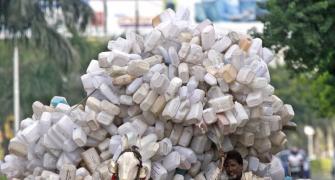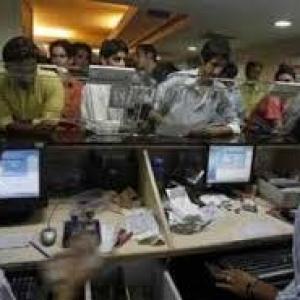India's good fortune, experts in the US feel, is not the result of a fundamentally strong economy, but because it is the best of a bad set of options. P Rajendran/Rediff.com listens in.
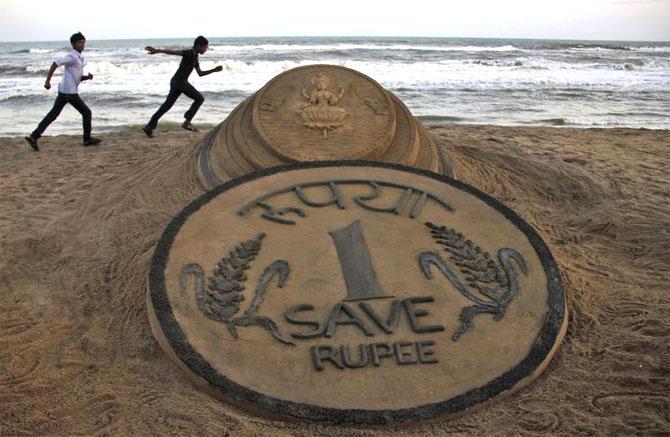
If Indian banks were privatised, the power sector fixed, and the laws streamlined, the conditions were ripe for India to do well. But all that is unlikely to happen. That was the upshot of a conversation on Current Economic Conditions in India Under the Modi Government held at a reunion of alumni of the Indian Institute of Technology-Bombay in Jersey City.
Before the discussion began, moderator Gagan Singh, executive vice-president and chief investment officer at PNC Bank, expressed his optimism in the Indian economy -- as seen in stock prices.
He told Rediff.com he was optimistic, given that the values of top performers had growing multiple times since the liberalisation of India's economy in 1991.
Viral Acharya, C V Starr Professor of Economy at New York University's Stern Business School, described what he found positive and worrisome about the Indian economy.
"We have not faced the emerging markets outflow of funds that has happened since it's become clear that the Federal Reserve is going to raise interest rates," he said, explaining that when big countries kept rates low, fund managers look outward for places giving good returns. This has been particularly good for emerging markets since 2008 or so. He pointed out that the trend will reverse itself once the Fed raises rates again.
Despite a torrid few months in 2013, when the value of the rupee plunged, Acharya said things have improved in India, particularly after Narendra Modi took over the government and Dr Raghuram Rajan became governor of the Reserve Bank of India.
"The government has done what one sets as a minimum bar for a government, which is to not do any damage," Professor Acharya said. "Regardless of whether the government has done a lot of good, they have at least not blown the government balance sheet, they haven't expanded the subsidies program in a massive way without figuring out how to fund them, without raising deficits, etc."
But, he pointed out, business leaders in India were not as excited as those outside the country were. He put it down to the parlous health of Indian corporations and banks and said that factor was not getting sufficient attention in the popular press in the US. He pointed out that 13 to 15 percent of bank loans in India were likely to go bad or was already there.
Most losses came from the steel and metal sector, Professor Acharya added, with China flooding the market with cheap products.
While things was not as bad as Brazil and Turkey, India still needed to work on better regulation, he said, adding that it was a bad idea also to have 75 percent of the banks being government owned, especially since the government was used to interfering in functioning.
One example of this was that in an election year no farm loan in India went bad.
When risk-taking banks ran into trouble, financially secure banks like the HFDC Bank ought to be allowed to buy its good assets, he said, adding that Indian protectionist laws will not allow even a branch to be sold without a lot of legal maneuvering.
"So the capital mobility we need -- from the 25 percent of the banking sector that is healthy... to the 75 percent that's making the bulk of the losses to steel and metals is just not happening," he said, adding that there was no pressure from foreign investors for India to change its laws.
The RBI, he said, could put pressure on the banks, but the government may keep throwing money at sick banks.
"We will come out of this with very tepid (to) moderate growth," Professor Acharya said, warning that Indian banking risked something like what happened in Japan in the 1990s.
The sales of commercial vehicles were up 25 to 30 percent after declining for four years, and mining was clearly recovering, Arvind Sanger, managing partner at Geosphere Capital, said.
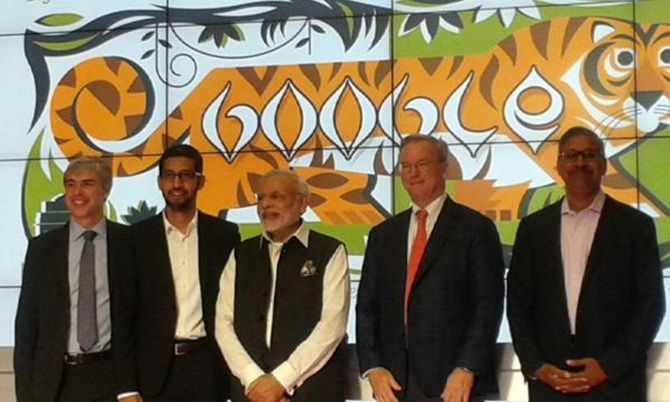
"Modi is doing a fine job in selling India to the world and creating a positive image," Sanger said. "At the end of the day, self-confidence -- and confidence is everything -- can be part of the virtuous cycle."
But investors also needed to see evidence on the ground, he said, adding these could be in land acquisition, fixing the banking sector, or labor reform.
Low commodity prices have helped reduce the problem of India's budget deficit by itself, and current account deficit issues have also been fixed by external forces.
"India's in a sweet spot, but that's... not going to last forever," he said, adding that India tended to take difficult decisions only when its back was to the wall.
The seven percent Gross Domestic Product being discussed was specious, he said, and felt that such talk made people complacent.
India had the best combination of CEO (Modi) and central banker (Rajan) of any major economy, Navroz Udwadia of Falcon Edge Capital, said.
Other similar nations were not doing as well, he said. Brazil is in recession, Russia is fighting two wars, China is in deflation and has debt to GDP ratio more than 300 percent (relative to India's 100 percent), South Africa had currency issues and was also hit badly because it is a commodity-based market, and Turkey is a geopolitically bad location. All this meant that emerging markets managers had only India as a secure option.
This, Udwadia said, meant that India's good fortune was not a result of a fundamentally strong economy but because it was the best of a bad set of options. The current account deficit, which was 4 percent under the previous Congress-led government, was at 0 percent now because of a fall in oil and gold prices, he added.
Subsidies has also been slashed, diverting money to more productive end users. Ecommerce has expanded, partly driven by IIT alumni.
The bad news, Udwadia, said included the fact that India has a total debt of $1 trillion. Then, of the 22,500 publicly listed companies with debt on their balance sheets, 50 percent have interest expenses that cannot be covered by operating profits; that 50 percent accounts for 28 percent of system debt.
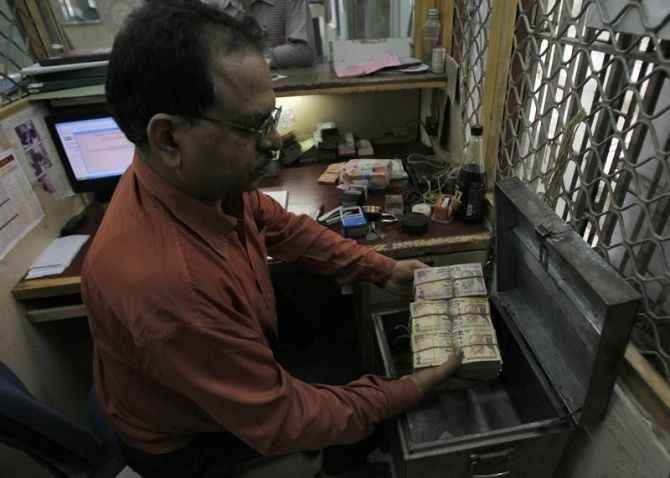
Professor Acharya was being kind, Udwadia said, when he used public sector bank figures to say that unrecoverable bad loans are at around 10 percent. The actual figure was somewhere between 10 percent, or $100 billion, and 28 percent, which was $280 billion.
Even taking it as at about 18 percent, or $180 billion, with recovery taken as 50 percent (or $80 billion to $90 billion), he said, there still was a $100 billion hole to fill. "Without that being fixed, credit -- which is the lubricant of a growing economy and GDP growth -- cannot be extended," Udwadia said, pointing out to a weak government plan, Indradhanush, which called for $40 billion from the private sector and $10 billion from the government.
"Which private investors will pony up 40 billion dollars for a banking system that is government-owned and poorly run?" he asked, pointing out that 70 percent of credit is owned by publicly owned banks.
"Show me another economy where the government owns 27 banks," he said. "There's a big structural problem in India, and until we figure out how to fix that banking system, you cannot have a sustainable seven, eight, nine, ten percent growth of the economy."
The problem, Udwadia said, was foisted on the current government by the last 10 years of non-economic lending instigated by the previous administration for political reasons. Professor Acharya, he said, was not right when he said the steel and metals sector played a huge role in the number of bad debts, and argued that the power sector was the real problem.
"The power sector accounts for 30 percent of all non-performing loans in India," he said, adding that of the $180 billion in debt, $60 billion came from this sector. Of that figure, $40 billion could be blamed on state electricity boards. Udwadia said these boards lost 40 percent of its power to vote banks and other forms of what he called theft.
"Until you fix the power sector, following which the banking sector can be fixed, I have deep apprehensions about the sustainability of the capital markets or economic growth in the country," he said, adding that while 40 percent of India lacked power despite the discovery of local coal, if only because those who buy power are bankrupt.
Replying to a question from Singh about places to invest in India, Sanger said public firms were very risky options. He gave two examples.
If the Steel Authority of India Limited sold iron ore and shut down all its steel-making plants it would make more profit, he said, arguing that the public firm actually destroyed value while converting iron ore to steel.
SAIL was also upgrading capacity 60 percent, but at three times the cost incurred by the privately-owned JSW Steel.
A positive sign for private firms was that, in the absence of subsidies, PVC pipe sales were up despite a shortage of rain because the farmers now sought efficiency.
Another area for possible investment is ecommerce, Sanger said, asserting that the bad traffic that made shopping such a nightmare in India could be a spur for the new economy. Udwadia said his recommendations were similar to Sanger's, though he listed private banks, healthcare and pharmaceutical firms. He also spoke of some quiet, self-driven entrepreneurs and gave the example of one man behind a publicly listed company.
"The founder and owner has raised -- in a country where promoters are famous for constantly raising capital as they suck it out of their company -- 50 million dollars in capital one time ten years ago and is laser-ly focused on driving a 40 percent return on invested capital, and has created six billion dollars," he said.
When it came to investments, Udwadia said his best bets were private banks, which were still only at 28 percent lending, up from 10 percent five years ago, and ecommerce options.
India, he said, could stop focusing on its 3.5 percent fiscal deficit to take advantage of the low prices worldwide -- for oil, steel copper, etc -- and build much-needed infrastructure. In fact, unlike lending to farmers, which drove inflation, fixing infrastructure would be deflationary over the long term, Udwadia added.
The finance minister, he said, may argue back that such measures could make India lose investment grade.
"Why does India care about investment grade?" Udwadia asked, countering the hypothetical government response. "A tiny percent of Indian debt (10 to 15 percent) is foreign denominated."
Sanger backed that view, saying the National Highways Authority of India underspent its budget in the past year. Private sectors firms have seen five percent growth in the first five months of this year.

